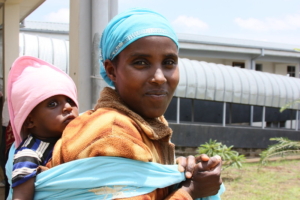Addressing the Humanitarian Crisis in Ethiopia
 For the second year in a row, Ethiopia has ranked second on the International Rescue Committee (IRC) Emergency Watchlist, indicating that it is one of the countries most threatened by a growing humanitarian crisis in 2023. As Africa’s oldest sovereign nation, it has the second-highest population on the continent, with an estimated 116,462,712 inhabitants in 2023, according to the CIA World Factbook. Additionally, Ethiopia has the third highest refugee population in Africa, hosting over 924,000 refugees and asylum seekers, mainly from South Sudan, Somalia and Eritrea. Thus, the deteriorating situation in Ethiopia poses a great threat to many.
For the second year in a row, Ethiopia has ranked second on the International Rescue Committee (IRC) Emergency Watchlist, indicating that it is one of the countries most threatened by a growing humanitarian crisis in 2023. As Africa’s oldest sovereign nation, it has the second-highest population on the continent, with an estimated 116,462,712 inhabitants in 2023, according to the CIA World Factbook. Additionally, Ethiopia has the third highest refugee population in Africa, hosting over 924,000 refugees and asylum seekers, mainly from South Sudan, Somalia and Eritrea. Thus, the deteriorating situation in Ethiopia poses a great threat to many.
According to the IRC, 28.6 million people living in Ethiopia currently require humanitarian aid, 20 million are suffering from food insecurity, 3.5 million have been internally displaced and 31.9 million are struggling with the impacts of continuous drought. There is a need for urgent action to alleviate the worsening humanitarian crisis in Ethiopia.
Factors Contributing to the Humanitarian Crisis in Ethiopia
Several factors have contributed to the humanitarian crisis in Ethiopia, including ongoing drought, conflict, food insecurity, economic instability, disease outbreaks, climate shocks, the war in Ukraine and the COVID-19 pandemic.
For instance, in November 2020, armed conflict between the Ethiopian government and the Tigray People’s Liberation Front, a nationalist rebel group, left thousands dead and millions internally displaced. Although a peace deal was announced in November 2022, fighting continues in the Tigray region. This has posed numerous risks and challenges to providing sufficient aid for the region’s 5.2 million inhabitants, almost 40% of whom suffer from an extreme lack of necessary food resources. Ongoing conflict elsewhere in Ethiopia, for example in the country’s Somali region, has similarly disrupted aid efforts while exacerbating the humanitarian crisis.
Furthermore, an unpredictable climate has worsened the crisis. Continually threatened by drought, Ethiopia is now entering its sixth consecutive season without sufficient rainfall. As a result, many Ethiopians face the risk of starvation and lack of access to safe drinking water. These issues have led to cholera outbreaks, weakening the immune systems of affected people due to undernutrition. Children, in particular, are suffering from food scarcity and insufficient nourishment.
At the same time, heavy rains and flooding have threatened livelihoods, displaced people and destroyed shelters in the Oromia, Somalia and Afar regions. The resulting death of cattle has been devastating, as many Ethiopians rely on livestock and agriculture for income and sustenance.
Economic Challenges
Economic instability has only heightened the severity of the situation. Globally rising prices and supply disruptions have added to Ethiopia’s economic strain and made vital resources increasingly scarce. In May 2022, inflation in the country reached a 37.7% high and, while it has since lowered, food prices remain at a peak. With Ethiopia relying heavily on imports to meet the country’s demand for wheat, globally increasing prices of fuel, fertilizers, steel, iron and other such products in light of the war in Ukraine are having detrimental effects.
Humanitarian Aid to Ethiopia
Despite attempts to deliver aid to Ethiopia, insufficient funding has hindered the humanitarian response. Health assistance has only reached 12% of people in need in drought-affected areas, and less than 30% have gained access to water, sanitation and hygiene equipment.
The IRC has, however, been providing support to refugees in Ethiopia, as well as to those most affected by drought and fighting since 2000. The organization has also extended its relief efforts to alleviate the impacts of COVID-19. It has partnered with local organizations to deliver supplies to vulnerable communities and implement safe water supply systems and sanitation facilities. Moreover, the IRC has worked to strengthen community healthcare, train teachers and provide training and job opportunities for young people and households considered at high risk.
Alongside the IRC, the United Nations Refugee Agency has collaborated with the Ethiopian government and local organizations to help aid and protect millions of refugees displaced by conflict. The U.N. agency’s relief efforts have included providing emergency shelters, safe drinking water, food, blankets, sleeping mats and other resources to those fleeing conflict in Tigray.
The U.S. has also thus far contributed around $714 million to the 2023 Ethiopian Humanitarian Response Plan, and Germany, Japan and Sweden have contributed some $14 million to the 2023 Ethiopia Humanitarian Fund.
Looking Ahead
While these efforts offer growing hope, a recent report issued by the United Nations Office for the Coordination of Humanitarian Affairs (UNOCHA) makes clear that further support “is urgent and critical.” In other words, only with such support can humanitarian efforts continue, expand and succeed in giving the many who are afflicted by ongoing conflict and disaster in Ethiopia a fair chance at life.
– Bethan Marsden
Photo: Flickr
